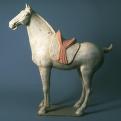T’ang
(618-907)
Five years later her banished son, Hsüan-tsung, returned to begin the most influential reign of the T’ang emperors. A man of many talents, including loyalty and wisdom, Emperor Hsüan-tsung, restored frugality to the palace, created a fair tax code, and restyled the military. In Western terms a Renaissance Man, the Emperor opened his court to scholars, artists, foreigners, and various religions. He surrounded himself with few, but brilliant, advisors and banished the eunuchs.
Under his rule China flourished, but with the passing years the Emperor lost interest in governing, instead turning his interests to Taoism. His indifference opened the door to rebellion, and for seven years the country suffered war waged by a governor named An Lu-shan. Though put down, a frail state was left in its wake. The eunuchs returned, choosing each emperor to the last of T’ang. The institutions that defined the dynasty were strained and twisted almost beyond recognition. Its last days were marked by battles over the tax code and Buddhist church, foreign threats, gangsterism, floods, and droughts. Wracked by purges and financial collapse, Heaven’s Mandate was revoked and T’ang fell.
